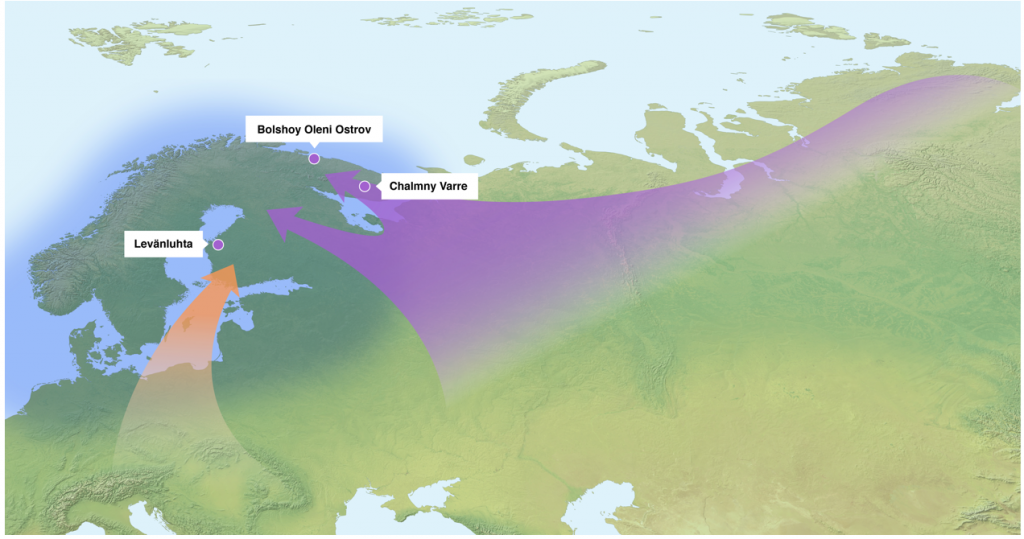Press release Nov 27, 2018: Ancient DNA shows the Sámi and Finns share identical Siberian genes
Article “Ancient Fennoscandian genomes reveal origin and spread of Siberian ancestry in Europe” has been published in Nature Communications
- Press release for Finnish media Nov 27, 2018 (pdf)
- Press release for international media – published by Max Planck Institute (pdf)
Ancient DNA shows the Sámi and Finns share identical Siberian genes
An abundance of genes has journeyed all the way from Siberia to Finland, a recent study indicates. As late as during the Iron Age, people with a genome similar to that of the Sámi people lived much further south in Finland compared to today.
The first study on the DNA of the ancient inhabitants of Finland has been published, with results indicating that an abundance of genes reached Finland all the way from Siberia.
Genetic material from Siberia has been found in the inhabitants of the Kola Peninsula from as far back as approximately 4,000 years ago, later spreading also to Finland. The study also corroborates the assumption that people genetically similar to the Sámi lived much further south in Finland than today even during the Iron Age.
The genetic samples compared in the study were collected from human bones found in a 3,500-year-old burial place in the Kola Peninsula and the 1,500-year-old lake burial site at Levänluhta in South Ostrobothnia, Finland. All of the samples contained identical Siberian genes.
Siberian origin remains perceptible
The ancient DNA has also been compared to modern populations. Siberian origins are still visible in the Sámi, Finns and other populations of the Finno-Ugric language family.
“However, it has been mixed up with the European genome. Of all European populations, modern Sámi are the most evident representatives of the Siberian genome. As for the title of the modern people with the largest Siberian genetic component, that privilege goes to the Nganasan people living in northern Siberia,” says Päivi Onkamo, head of the SUGRIGE project at the Universities of Helsinki and Turku.
The results make it possible to hypothesise that the living habits, languages and culture of ancient Siberians and the communities that inhabited Finland in the Bronze and Iron Ages may have been in active contact with each other, regardless of the long distance between them. Part of the population may have travelled extensively, trading and moving from one settlement to another according to seasonal changes.
 A map of the burial places: The bones studied in the project were from eleven individuals exhumed in Ostrobothnia and the Kola Peninsula. Map: Max Planck Institute for the Science of Human History
A map of the burial places: The bones studied in the project were from eleven individuals exhumed in Ostrobothnia and the Kola Peninsula. Map: Max Planck Institute for the Science of Human History
The deceased in the Levänluhta site most closely resemble the Sámi
The project succeeded in mapping out the entire genome from the bones of eleven individuals. From the Kola Peninsula, the bones of six individuals were collected from a 3,500-year-old burial place, while those of two individuals were found from another location dating back to the 18th and 19th century. In the case of the bones found in the Levänluhta site in South Ostrobothnia, the entire genome was mapped for three individuals.
Levänluhta is one of the oldest burial sites in Finland with preserved human bones. The deceased were buried in a lake located at the spot, which explains why the bones have been so well preserved. The study indicates that the local people were more closely related to today’s Sámi than to Finns.
“A population genetically similar to the Sámi has at one time inhabited Finland further south than could be concluded from the settlements of the modern Sámi populations,” says Kerttu Majander, a researcher at the University of Helsinki and the Max Planck Institute for the Science of Human History in Germany.
“According to another recently published study, the influence of the Sámi has been observed in the names of the Levänluhta region,” adds Dr. Anna Wessman at the University of Helsinki, project manager of the Levänluhta project .
The results have been published in the Nature Communications online journal. The research was carried out in cooperation between the SUGRIGE project on ancient genes of the Universities of Helsinki and Turku, the Levänluhta project and the Max Planck Institute for the Science of Human History in Germany, focused on studying human prehistory.
Further information by topic:
Ancient DNA, population genetics, ancient Finno-Ugrian DNA, SUGRIGE project:
Researcher Kerttu Majander, University of Helsinki and Max Planck Institute for the Science of Human History, tel. tel. 27–30 November +358 41 3678636 and from 1 December
+49 176 9852 3868, majander@shh.mpg.de
Professor Päivi Onkamo, group leader for the SUGRIGE project, University of Turku and University of Helsinki, tel. +358 2941 59111, paivi.onkamo@utu.fi
Levänluhta:
Archaeological context: Dr Anna Wessman, project manager for the Levänluhta project, University of Helsinki, tel. +358 50 329 8436, anna.wessman@helsinki.fi
Professor Antti Sajantila, DNA research under the Levänluhta project, University of Helsinki, tel. +358 400 605 205, antti.sajantila@helsinki.fi